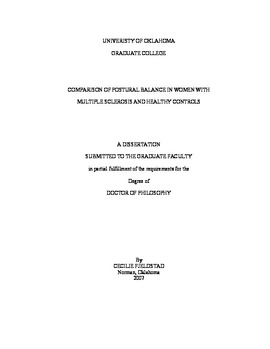| dc.contributor.advisor | Bemben, Michael G., | en_US |
| dc.contributor.author | Fjeldstad, Cecilie. | en_US |
| dc.date.accessioned | 2013-08-16T12:20:50Z | |
| dc.date.available | 2013-08-16T12:20:50Z | |
| dc.date.issued | 2007 | en_US |
| dc.identifier.uri | https://hdl.handle.net/11244/1227 | |
| dc.description.abstract | Purpose. The primary purpose of this study was to compare balance in women with Multiple Sclerosis (MS), and healthy controls. The secondary purpose was to investigate the relationship between balance and Expanded Disability Status Scores (EDSS) in patients with MS. Methods. Subjects included 67 women with MS (X= 43.9 +/- 1.2 years) and 45 healthy controls (X = 40.4 +/- 2.4 years). The MS group was diagnosed with this form of neurological disorder by a single MS neurologist and had a score of ≤ 5 on the EDSS. Both groups included women between 18-64 years of age who underwent a series of six balance measures by the use of the Neurocom Balance Master. The MS group also filled out the MSQOL-54, and the healthy controls the PAR-Q and a Health Status Questionnaire. Results. There was a significant difference for weight between the MS (X = 76.8 +/- 2.8 kg) group and healthy controls (X = 64.3 +/- 1.6 kg), with the MS group being significantly heavier (p< 0.01), but no significant differences were found for age or height (p>0.05). For the following balance measures (deg/sec), there was a significant difference between the two groups, with the MS group doing worse for unilateral stance eyes open, unilateral stance eyes closed, tandem walk end sway, and MCTSIB measures standing on foam surface with closed eyes (p< 0.01). Step quick turn (deg), did not differ significantly between the MS group and the healthy control group after adjusting for age (p>0.05). Evaluating the EDSS subcomponents, there was a significant difference for sensory function and duration of disease in the MS group (p< 0.05). Conclusions. The results from this study indicate significantly more postural instability in the MS group when compared to healthy controls. Also, the group diagnosed with MS for 10.1-20yrs had more impaired sensory function as measured by the EDSS compared to the other MS groups (.1-10yrs and 20.1-33yrs) (p< 0.05). | en_US |
| dc.format.extent | x, 126 leaves : | en_US |
| dc.subject | Education, Physical. | en_US |
| dc.subject | Health Sciences, Rehabilitation and Therapy. | en_US |
| dc.subject | Equilibrium (Physiology) | en_US |
| dc.subject | Multiple sclerosis. | en_US |
| dc.title | Comparison of postural balance in women with multiple sclerosis and healthy controls. | en_US |
| dc.type | Thesis | en_US |
| dc.thesis.degree | Ph.D. | en_US |
| dc.thesis.degreeDiscipline | Department of Health and Exercise Science | en_US |
| dc.note | Adviser: Michael G. Bemben. | en_US |
| dc.note | Source: Dissertation Abstracts International, Volume: 68-05, Section: A, page: 1864. | en_US |
| ou.identifier | (UMI)AAI3264595 | en_US |
| ou.group | College of Arts and Sciences::Department of Health and Exercise Science | |
